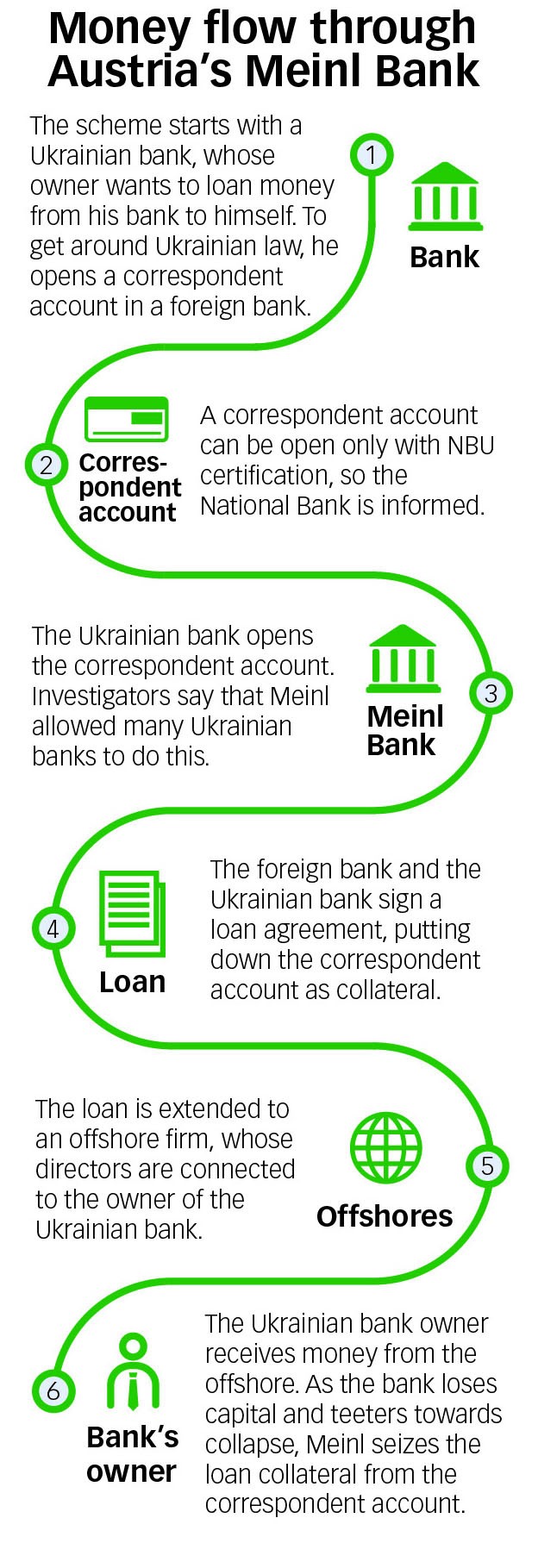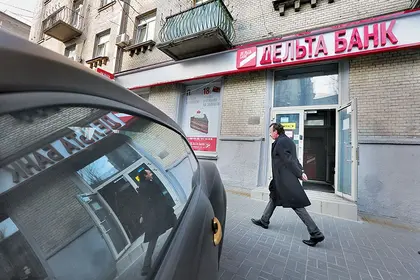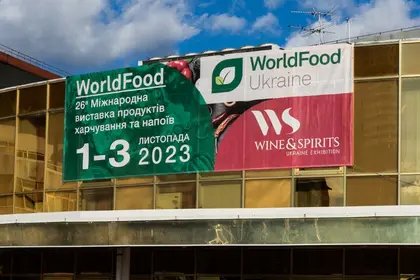In 1996, Austrian aristocratic scion Julius Meinl V was ready to move back east.
The Soviet Union had collapsed and Meinl — the fifth in a line of Julius Meinls extending back to the man who founded a luxury grocery company of the same name in 1862 — saw an opportunity. Meinl V began to turn the family company from its focus on groceries for Vienna’s richest into a financial services provider, shutting down the company’s food providers and infusing the family-run bank — Meinl Bank AG — with more cash throughout the 1990s.
But fraud scandals have dogged Meinl Bank throughout its existence.
Now, Ukrainian prosecutors are investigating how Meinl Bank apparently funneled $1.5 billion out of the country, while the National Anti-Corruption Bureau of Ukraine is probing the central bank itself for allegedly allowing the money to be taken.

Government regulators differ on exactly how many banks used the scheme. The NBU claims a total of 17 banks were involved — 11 of which have since been declared insolvent.
NABU is now investigating the cases of nine separate banks that used the scheme over two stages. Those banks are Kyivska Rus, Tavrika Bank, Finrost Bank, Integral Bank, Finance and Credit, City Commerce Bank, Avtokraz Bank, Delta Bank and Pivdenkom Bank.
The probe focuses on two stages in the scheme — the disappearance of $389 million after the fraud’s alleged birth in 2011, and the NBU-backed refinancing of those same banks in 2014 and 2015 that totalled an additional $570 million.
The Anti-Corruption Action Center, a Kyiv nongovernmental organization led by activist Daria Kaleniuk, first reported the scheme in February 2016. NBU Governor Valeria Gontareva said at her April 10 resignation conference that she had spoken with the Austrian Central Bank chief about the issue in September 2014, and that the conversation had put an end to the scheme.
But according to the state Deposit Guarantee Fund, losses continued until December 2015, more than a year after the Austrian Central Bank supposedly learned of the scheme.
In February 2017, the Vienna public prosecutor began looking into Meinl Bank’s involvement in the scheme.
Samira Softic, a member of the bank’s managing board, declined to comment multiple times. The Austrian Central Bank did not reply to a request for comment.
Moving east
Austria’s financial ties to Eastern Europe extend back to the Habsburgs and through to the Soviet Union, which ran an alleged money-laundering front called Donau Bank out of Vienna.
Julius Meinl said in a 2007 statement upon selling a Romanian candy firm that the company was “early to move back into those markets where Julius Meinl was active before the War.”
The company’s investments in Ukraine brought it into contact with the same bank owners who would later use the bank to shift cash abroad.
Meinl Bank owns a number of investment funds. One fund, Meinl European Land, agreed to invest $150 million to build a shopping mall in Odesa in 2007. That fund later collapsed amid fraud allegations.
Gregory Gurtovoy, a former director of the collapsed FinBank and a former co-owner of the insolvent Platinum Bank, who has been detained in Israel on separate embezzlement charges, held stock in Israeli corporations through Meinl Bank, according to 2017 U.S. securities filings.
Another mutual fund — Meinl Eastern Europe — has been a longtime investor in Ferrexpo, a Switzerland-registered iron ore producer owned by Ukrainian multimillionaire Kostyantyn Zhevago. Bank Finance and Credit, owned by Zhevago, is one of the banks that is under investigation for laundering money out of the country via Meinl.
Flushing cash away
The Meinl scheme was essentially an insider lending operation that required the use of a foreign bank with a permit from the NBU.
A Ukrainian bank would ask to open a correspondent account at Meinl, or another foreign bank involved in the scheme. Opening the correspondent account required NBU approval, according to former NBU official Oleksandr Zavadetsky and researchers at the Anti-Corruption Action Center.
The Ukrainian bank would then deposit money in the correspondent account, and sign a loan agreement with its Austrian counterpart agreeing to use the cash in the correspondent account as collateral.
The Austrian bank would then loan money to a third party shell company, linked to the management of the Ukrainian bank. The loan’s collateral would be the money in the Ukrainian bank’s correspondent account.
The Ukrainian bank would not register the loan agreements in its internal books, artificially inflating its capital while allowing money to go from depositors to the bank’s owners. When things turned south for the bank, Meinl would collect by seizing the collateral in the correspondent account.
The amount that Meinl seized from the correspondent account would roughly reflect the amount of insider lending funneled through Austria. One case, involving Bank Kyivska Rus’, saw Meinl remove $44 million in June 2015, according to the Deposit Guarantee Fund. Finance and Credit — Zhevago’s bank — had $53.7 million removed by Meinl in September 2015.
The Deposit Guarantee Fund has identified losses from the scheme, including Meinl Bank as well as Bank Winter in Austria, Bank Frick in Lichtenstein, and East-West United in Luxembourg, at $748 million and 75 million euros.
Who’s responsible?
NABU detectives are investigating the NBU’s banking supervision department over whether or not they knowingly refinanced banks that were using the Austrian scheme, and whether or not the banks that received the state loans were eligible for refinancing under Ukrainian law.
Those banks are City Commerce Bank, Tavrika Bank, Finrost Bank, Avtokraz Bank, Delta Bank, Pivdenkom Bank, Finance and Credit, Integral Bank, and Kyivska Rus’ Bank.
Receiving the refinancing loans would have automatically installed an NBU curator into the bank.
“The curator would have seen everything,” said Zavadetsky, the former NBU official.

The NBU is hamstrung in some senses — even though it has curators that can see transactions occurring at a bank in real time, it can only act ex post facto, and only has civil regulatory authority to pursue wrongdoers.
Amid accusations that it permitted the scheme to take place, the NBU put out a statement saying that as of the middle of 2014, nearly $2 billion was registered on the correspondent accounts of 17 Ukrainian banks that were using the system.
The NBU also put out its own, separate list of 11 banks involved in the scheme that were later declared insolvent. Those banks were: Bank “National Investments,” EnergoBank, National Credit, Bank Kyivska Rus’, Bank Mikhailivsky, Delta Bank, Integral-Bank, Finance and Credit, Ukrainian Professional Bank, Ekspobank, and City Commerce Bank.
On the Austrian side, Meinl’s involvement will be hard to prove. Annika Wolf, a banking attorney at PHH law firm in Vienna, said that it would be necessary to prove intent to launder money on Meinl’s part. A charge of failure to have money laundering controls in place would be easier to achieve.
“You have to know where the money was coming from,” she told the Kyiv Post.
So far, NABU and Austrian prosecutors are cooperating on the case. The Austrian authorities have filed three requests with Ukrainian prosecutors, while the Ukrainians have sent 10 separate requests to Austria over the matter.
You can also highlight the text and press Ctrl + Enter







Comments (0)